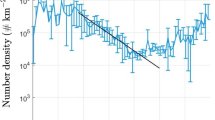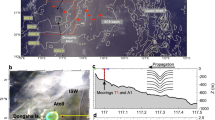Abstract
Breaking waves markedly increase the rates of air–sea transfer of momentum, energy and mass1,2,3,4. In light to moderate wind conditions, spilling breakers with short wavelengths are observed frequently. Theory and laboratory experiments have shown that, as these waves approach breaking in clean water, a ripple pattern that is dominated by surface tension forms at the crest5,6,7,8,9,10,11,12,13,14. Under laboratory conditions and in theory, the transition to turbulent flow is triggered by flow separation under the ripples, typically without leading to overturning of the free surface15. Water surfaces in nature, however, are typically contaminated by surfactant films that alter the surface tension and produce surface elasticity and viscosity16,17. Here we present the results of laboratory experiments in which spilling breaking waves were generated mechanically in water with a range of surfactant concentrations. We find significant changes in the breaking process owing to surfactants. At the highest concentration of surfactants, a small plunging jet issues from the front face of the wave at a point below the wave crest and entraps a pocket of air on impact with the front face of the wave. The bubbles and turbulence created during this process are likely to increase air–sea transfer.
This is a preview of subscription content, access via your institution
Access options
Subscribe to this journal
Receive 51 print issues and online access
$199.00 per year
only $3.90 per issue
Buy this article
- Purchase on Springer Link
- Instant access to full article PDF
Prices may be subject to local taxes which are calculated during checkout




Similar content being viewed by others
References
Cokelet, E. D. Breaking waves. Nature 267, 769–774 (1977)
Thorpe, S. A. Small-scale processes in the upper ocean boundary layer. Nature 318, 519–522 (1985)
Melville, W. K. The role of surface-wave breaking in air–sea interaction. Annu. Rev. Fluid Mech. 28, 279–321 (1996)
Jessup, A. T., Zappa, C. J., Loewen, M. R. & Hesany, V. Infrared remote sensing of breaking waves. Nature 385, 52–55 (1997)
Okuda, K. Internal flow structure of short wind waves. Part I. On the internal vorticity structure. J. Oceanogr. Soc. Jpn 38, 313–322 (1982)
Ebuchi, N., Kawamura, H. & Toba, Y. Fine structure of laboratory wind–wave surfaces studied using an optical method. Boundary-Layer Meteorol. 39, 133–151 (1987)
Longuet-Higgins, M. S. Capillary rollers and bores. J. Fluid Mech. 240, 659–679 (1992)
Longuet-Higgins, M. S. Shear instability in spilling breakers. Proc. R. Soc. Lond. A 446, 399–409 (1994)
Duncan, J. H., Philomin, H., Behres, H. & Kimmel, J. The formation of a spilling breaker. Phys. Fluids 6, 2558–2560 (1994)
Duncan, J. H., Philomin, V., Qiao, H. & Kimmel, J. The formation of a spilling breaker. Phys. Fluids 6, S2 (1994)
Longuet-Higgins, M. S. Capillary jumps on deep water. J. Phys. Oceanogr. 29, 1957–1965 (1996)
Tulin, M. P. in Waves and Nonlinear Processes in Hydrodynamics (eds Grue, J., Gjevik, B. & Weber, J. E.) 177–190 (Kluwer, Dordrecht, 1996)
Duncan, J. H., Qiao, H., Philomin, V. & Wenz, A. Gentle spilling breakers: crest profile evolution. J. Fluid Mech. 379, 191–222 (1999)
Ceniceros, H. D. & Hou, T. Y. Dynamic generation of capillary waves. Phys. Fluids 11, 1032–1050 (1999)
Qiao, H. & Duncan, J. H. Gentle spilling breakers: crest flow-field evolution. J. Fluid Mech. 439, 57–85 (2001)
Edwards, D. A., Brenner, H. & Wasan, D. T. Interfacial Transport Process and Rheology 1st edn (Butterworth-Heinemann, Boston, Massachusetts, 1991)
Poskanzer, A. M. & Goodrich, F. C. Surface viscosity of sodium dodecyl sulfate solutions with and without added dodecanol. J. Phys. Chem. 79, 2122–2126 (1975)
Longuet-Higgins, M. S. Proc. 10th Symp. Naval Hydrodynamics 597–605 (US Government Printing Office, Arlington, Virginia, 1976)
Melville, W. K. & Rapp, R. J. Momentum flux in breaking waves. Nature 317, 514–516 (1985)
Wei, Y. & Wu, J. In situ measurements of surface tension, wave damping, and wind properties modified by natural films. J. Geophys. Res. 97, 5307–5313 (1992)
Barger, W. R., Daniel, W. H. & Garrett, W. D. Surface chemical properties of banded sea slicks. Deep-Sea Res. 21, 83–89 (1974)
Longuet-Higgins, M. S. On the disintegration of the jet in a plunging breaker. J. Phys. Oceanogr. 25, 2458–2462 (1995)
Longuet-Higgins, M. S. & Dommermuth, D. G. Crest instabilities of gravity waves. Part 3. Nonlinear development and breaking. J. Fluid Mech. 336, 33–50 (1997)
Longuet-Higgins, M. S. & Cokelet, E. D. The deformation of steep waves on water. I. A numerical method of computation. Proc. R. Soc. Lond. A 350, 1–26 (1976)
Ceniceros, H. D. The effects of surfactants on the formation and evolution of capillary waves. Phys. Fluids 15, 245–256 (2003)
Sokatch, J. R. Bacterial Physiology and Metabolism (Academic, London, 1969)
Frew, N. M. in The Sea Surface and Global Change (eds Liss, P. S. & Duce, R. A.) 121–172 (Cambridge Univ. Press, Cambridge, 1997)
Miyano, K., Abraham, B. M., Ting, L. & Wasan, D. T. Longitudinal surface waves for the study of dynamic properties of surfactant systems. I. Instrumentation. J. Colloid Interface Sci. 92, 297–302 (1983)
Ting, L., Wasan, D. T., Miyano, K. & Xu, S.-Q. Longitudinal surface waves for the study of dynamic properties of surfactant systems. II. Air–solution interface. J. Colloid Interface Sci. 102, 248–259 (1984)
Mass, J. T. & Milgram, J. H. Dynamic behavior of natural sea surfactant films. J. Geophys. Res. 103, 15695–15715 (1998)
Acknowledgements
We thank H. Qiao for preliminary experiments on breaking waves in the presence of surfactants, and G. M. Korenowski for conversations on surfactant chemistry. This work is supported by the Ocean Sciences Division of the National Science Foundation.
Author information
Authors and Affiliations
Corresponding author
Ethics declarations
Competing interests
The authors declare that they have no competing financial interests.
Rights and permissions
About this article
Cite this article
Liu, X., Duncan, J. The effects of surfactants on spilling breaking waves. Nature 421, 520–523 (2003). https://doi.org/10.1038/nature01357
Received:
Accepted:
Issue Date:
DOI: https://doi.org/10.1038/nature01357
This article is cited by
-
Influence of the surface viscous stress on the pinch-off of free surfaces loaded with nearly-inviscid surfactants
Scientific Reports (2020)
-
Mathematical Modeling of Impinging Gas Jets on Liquid Surfaces
Metallurgical and Materials Transactions B (2011)
Comments
By submitting a comment you agree to abide by our Terms and Community Guidelines. If you find something abusive or that does not comply with our terms or guidelines please flag it as inappropriate.



